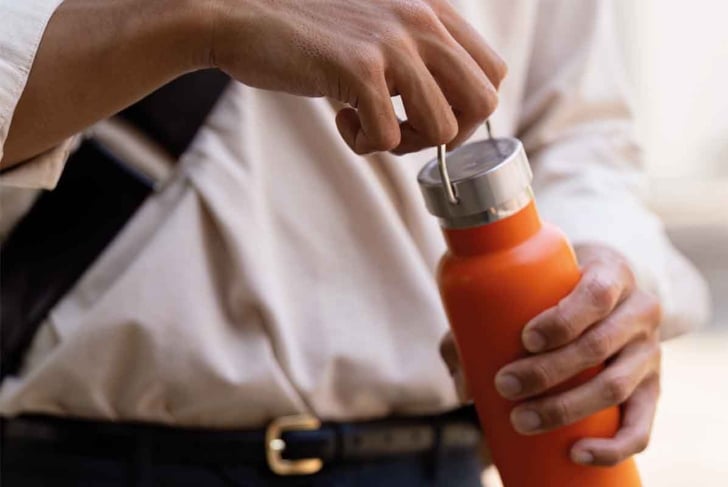
Whether heading abroad or on a road trip across the Prairies, summer is a peak travel time for millions of Canadians. While you may be focused on bookmarking favourite sightseeing spots in your travel guide and packing essentials like sunscreen, don’t forget an oft-overlooked essential of healthy travel: a healthy hydration plan—and your water bottle.
Dehydration can go sky high when flying
Studies have found most travellers forget to pay attention to how much they’re drinking, and may not realize that we can lose anywhere from 6% to 9% of our hydration levels on just one flight.
Hydration―an essential part of a great vacation
If you often get sick during or after a trip, you aren’t alone. Depending on the destination, upwards of eight out of 10 Canadians get sick after a vacation. This may be due to an array of factors, all of which hydration can play a part in ameliorating.
Weakened immune system
That enclosed airplane cabin is notoriously germ-ridden. Staying hydrated improves your immune system strength. For example, mucous membranes in your sinuses stay moist with proper hydration, thus aiding them in their role as natural defenders against viruses. Drinking water also flushes out toxins that build up on your trip, whether it’s bacteria or too many greasy poolside burgers.
Travel fatigue and time zone changes
Don’t let those red-eye flights leave you too tired to enjoy your destination. Lack of quality sleep weakens your immune system. Staying hydrated can help improve sleep and helps you overcome jet lag.
Acclimatizing to a new environment
Tropical destinations like Cuba and Mexico are some of the most popular destinations for Canadian travellers, and staying hydrated shields against heat-related health concerns.
Despite all the travel benefits of hydration, travel itself can be incredibly dehydrating.
Fuel your getaway
Travelling often involves long days of sightseeing and exploring. Hydration boosts your energy levels by delivering oxygen and nutrients to your muscles and brain, and helps prevent common dehydration-related symptoms like fatigue and dizziness.
“Fasten seat belt” sign = dehydration
“Dehydration during travel is a common issue,” warns registered nurse and avid traveller Valerie Creel. This is especially true if you’re flying.
“Airplanes have a much lower percentage of moisture in the air, because airplanes pull air from outside to pressurize the cabins; and being at [a] altitude makes the air naturally dry,” explains Creel. “Airplane cabins are also dehumidified. These two factors create an environment that has about 5 to 20 percent humidity, whereas the average home has about 40 to 60 percent.”
The result? Faster water loss simply by being on an airplane.
Even if you aren’t taking a flight, the simple act of travel is taxing on your hydration levels.
“It’s easy to get dehydrated while on the go, since travel disrupts our routine, exposes us to different climates, and often increases our physical activity (think: walking through airports or even just carrying luggage),” adds Stephanie Webb, a tour guide based in Niagara Falls.
“Combine that with a hectic travel schedule, unfamiliar water sources, and sometimes a little too much vacation indulgence (hello, cocktails!), and it’s no wonder so many of us end up feeling sluggish and dehydrated,” Webb adds.
What to pack to stay hydrated
Plan ahead to arrive at your summer destination feeling hydrated and looking glowy (chapped lips and dry skin don’t need to be inevitable).
Pre-flight checklist
Don’t wait until you’re thirsty; start hydrating at least four hours before you hit the road. “I try to up my water and eat foods with a high water content: things like cucumbers and oranges,” says Amy Neary, CEO of a network of IV hydration therapy clinics.
Reusable water bottle
“Bring a refillable water bottle and fill it after going through security,” suggests Valerie Creel, RN. “Having a refillable bottle is also really handy during your trip.”
Electrolytes and supplements
“Replacing your sodium, potassium, and magnesium is especially helpful after flights,” says Neary, who also recommends coconut water, hyaluronic acid supplements, and B vitamins to “help with energy and cellular hydration.”
Hydrating toiletries
“Bring a travel-size bottle of lotion and lip balm,” suggests Creel. If you’re especially prone to dry, irritated sinuses and eyes, she recommends also packing nasal spray and eye drops.
Make hydration part of your travel plan
Before you toss that luggage into your vehicle, toss back a glass of water and plan ahead.
“When people travel, they’re so focused on the logistics that hydration just falls to the bottom of the list,” says Amy Neary, CEO of a network of IV hydration therapy clinics.
“But staying hydrated is one of the simplest and most powerful ways to support your body when you’re on the move,” adds Neary. “Dehydration can show up in so many ways: fatigue, headaches, brain fog, digestive issues, and even a weaker immune system―which are the last things you want when you’re in a new place. Hydration needs to be on your packing list, right next to your passport.”
Safe water FAQs
Is the drinking water at my destination safe?
Check the Government of Canada’s travel advisories for the country you’re visiting for the most up-to-date information on whether the water there is safe to drink.
What are the easiest precautions to take?
“Choose bottled water if you have any doubts about water safety,” says Creel. “In some countries, it may be a good idea to skip ice in your drinks and use bottled water to brush your teeth.”
When should I see a doctor?
If you discover the water you’ve consumed is contaminated water, consult a doctor if you’ve been sick for longer than two days, have severe pains, notice blood after going to the bathroom, or have a fever above 39 C (102 F).
This article was originally published in the July 2025 issue of alive magazine.





